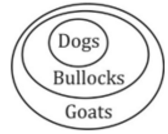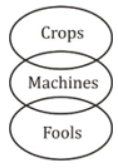SSC Stenographer Syllogism Questions and Answers download PDF based on previous year question papers of SSC exams. 20 Very important Syllogism Questions for Stenographer.
Download Syllogism Questions For SSC Stenographer
10 Stenographer Mock Tests – Just Rs. 117
Download All Important SSC Stenographer Questions PDF (Topic-Wise)
SSC Stenographer Free Mock Test (Latest Pattern)
SSC Stenographer Previous Papers
Instructions
In the following two questions, one statement is given followed by two Conclusions, I and II. You have to consider the statement to be true, even if it seems to be at variance from commonly known facts. You are to decide which of the given conclusions can definitely be drawn from the given statement. Indicate your answer.
Question 1: Statement : Aggressive animals can be trained with care and affection to behave
as the occasion demands.
Conclusions
I. Trained dogs cannot be aggressive.
II. Animals are always aggressive unless care and affection is given to them.
a) Both I and II follow.
b) Only I follows.
c) Only II follows.
d) Neither I nor II follows.
Question 2: Statement : Every school should promote partnerships that will increase parental involvement and participation for promoting the growth of children.
Conclusions :
I. For the growth of the children, parents should be involved in various school activities.
II. Involvement of parents in school activities has no influence on the growth of the children.
a) Both I and II follow
b) Only I follows
c) Only II follows
d) Neither I nor II follows
Question 3: Which one of the areas marked I – VII represents the urban educated who are not hardworking ? (Put Image)
a) I
b) III
c) IV
d) II
Question 4: Identify the diagram that best represents the relationship among the classes givenbelow:
Soda Water, Mineral Water, Liquid
a)
b)
c)
d)
Question 5: Two statements are given followed by four inferences. Select the alternative which is most appropriate.
Statements: India is becoming industrialised. Pollution is a problem associated with industrialisation Inferences:
I. All industrial centres are polluted.
II. India is polluted.
III. Polluted nations are industrialised.
IV. India may become polluted.
a) All are appropriate
b) None is appropriate
c) Only IV is appropriate
d) Only II is appropriate
Download SSC Stenographer Syllabus PDF
Instructions
In each of the following questions, a statement is given followed by two conclusions/ assumptions. You have to consider the statement to be true even if it seems to be at variance from commonly known facts. You have todecide which of the given conclusions/ assumptions, if any, follow from the given statement.
Question 6: Statement : If people are intelligent they should be creative.
Assumptions :
I. Creativity and intelligence are related.
II. Creative people are intelligent.
a) Both assumptions I and II are invalid.
b) Only assumption I is valid
c) Only assumption II is valid
d) Both assumptions I and II are valid.
Question 7: Statement : A friend in need is a friend indeed.
Conclusions :
I. All are friends in good times.
II. Enemies in bad times are not friends.
a) Neither Conclusion I nor II follows.
b) Only Conclusion 1 follows.
c) Only Conclusion H follows.
d) Both Conclusions I and II follow.
FREE SSC MATERIAL – 18000 FREE QUESTIONS
Instructions
In each of the following questions, one/two statements are given followed by three conclusions. You have to consider the statements to be true even it they seem to be at variance from commonly known facts. You have to decide which of the given conclusions, if any, follow from the given statements.
Question 8: Statement 1 : Water has no shape, has volume.
Statement 2 : The knowledge is, like water, flowed from one side to other.
Conclusion 1 : The knowledge is interdisciplinary
Conclusion 2 : The knowledge is bound within a specific area.
Conclusion 3 : The knowledge influences the core of mental activity directly.
a) Only Conclusion 1 follows.
b) Only Conclusion 2 follows.
c) Both Conclusions 1 and 2 follow.
d) Both conclusions 1 and 3 follow.
Question 9: Statements :
Some ladies are beautiful. Some beautifuls are honest. All honest are sensitives.
Conclusion 1 : Some sensitives are beautifuls.
Conclusion 2 : Some honest are ladies.
Conclusion 3 : Some sensitives are ladies.
a) None of the Conclusion follows.
b) Only Conclusion 1 follows.
c) Only Conclusions 1 and 2 follow.
d) All Conclusions follow.
1500+Free Must Solved SSC Questions (with Solutions)
Question 10: In the following question, two statements are given each followed by two conclusions I and II. You have to consider the statements to be true even if they seem to be at variance from commonly known facts. You have to decide which of the given conclusions, if any, follows from the given statements.
Statements:
(I) All shawls are carpets.
(II) No carpet is a pullover.
Conclusion:
(I) No shawls are pullovers.
(II) All carpets are shawls.
a) Conclusion I follows
b) Conclusion II follows
c) Neither I nor II follows
d) Both I and II follows
Question 11: In the following question, two statements are given each followed by two conclusions I and II. You have to consider the statements to be true even if they seem to be at variance from commonly known facts. You have to decide which of the given conclusions, if any, follows from the given statements.
Statements:
(I) Some scooters are trucks.
(II) All trucks are trains.
Conclusion:
(I) Some scooters are trains.
(II) No truck is a scooter.
a) Conclusion I follows
b) Conclusion II follows
c) Neither I nor II follows
d) Both I and II follows
Question 12: In the following question, two statements are given each followed by two conclusions I and II. You have to consider the statement to be true even if they seem to be at variance from commonly known facts. You have to decide which of the given conclusions, if any, follows from the given statements.
Statements:
(I) Some books are toys.
(II) No toy is red.
Conclusion:
(I) Some books are red.
(II) Some toys are books.
a) Conclusion I follows
b) Conclusion II follows
c) Neither I nor II follows
d) Both I and II follows
Question 13: In the following question, two statements are given each followed by two conclusions I and II. You have to consider the statements to be true even if they seem to be at variance from commonly known facts. You have to decide which of the given conclusions, if any, follows from the given statements.
Statements:
(I) All dogs are rats.
(II) Some rats are lizards.
Conclusion:
(I) Some dogs are lizards.
(II) Some lizards are dogs.
a) Conclusion I follows
b) Conclusion II follows
c) Neither I nor II follows
d) Both I and II follows
SSC STENOGRAPHER PREVIOUS PAPERS
Question 14: In the following question, two statements are given each followed by two conclusions I and II. You have to consider the statements to be true even if they seem to be at variance from commonly known facts. You have to decide which of the given conclusions, if any, follows from the given statements.
Statements:
(I) All flowers are stems.
(II) All stems are roots.
Conclusion:
(I) All roots are flowers.
(II) All stems are flowers.
a) Conclusion I follows
b) Conclusion II follows
c) Neither I nor II follows
d) Both I and II follows
Question 15: In the following question, two statements are given each followed by two conclusions I and II. You have to consider the statements to be true even if they seem to be at variance from commonly known facts. You have to decide which of the given conclusions, if any, follows from the given statements.
Statements:
(I) Some bags are hot.
(II) All hot things are cakes.
Conclusion:
(I) All cakes are bags.
(II) All bags are cakes.
a) Conclusion I follows
b) Conclusion II follows
c) Neither I nor II follows
d) Both I and II follows
Question 16: In the following question, two statements are given each followed by two conclusions I and II. You have to consider the statements to be true even if they seem to be at variance from commonly known facts. You have to decide which of the given conclusions, if any, follows from the given statements.
Statements:
(I) All young girls are modern.
(II) No modern men are superstitious.
Conclusion:
(I) No girls are superstitious.
(II) No young men are superstitious.
a) Conclusion I follows
b) Conclusion II follows
c) Neither I nor II follows
d) Both I and II follows
Question 17: In the following question, two statements are given each followed by two conclusions I and II. You have to consider the statements to be true even if they seem to be at variance from commonly known facts. You have to decide which of the given conclusions, if any, follows from the given statements.
Statements:
(I) All pilots are brave men.
(II) All astronauts are pilots.
Conclusion:
(I) All astronauts are brave men.
(II) Some pilots are astronauts.
a) Conclusion I follows
b) Conclusion II follows
c) Neither I nor II follows
d) Both I and II follows
Question 18: In the following question, two statements are given each followed by two conclusions I and II. You have to consider the statements to be true even if they seem to be at variance from commonly known facts. You have to decide which of the given conclusions, if any, follows from the given statements.
Statements:
(I) All dogs are bullocks.
(II) All bullocks are goats.
Conclusion:
(I) All dogs are goats.
(II) All goats are dogs.
a) Conclusion I follows
b) Conclusion II follows
c) Neither I nor II follows
d) Both I and II follows
Question 19: In the following question, two statements are given each followed by two conclusions I and II. You have to consider the statements to be true even if they seem to be at variance from commonly known facts. You have to decide which of the given conclusions, if any, follows from the given statements.
Statements:
(I) Most crops are machines.
(II) Some machines are fools.
Conclusion:
(I) Some fools are machines.
(II) Some crops are fools.
a) Conclusion I follows
b) Conclusion II follows
c) Neither I nor II follows
d) Both I and II follows
Question 20: In the following question, two statements are given each followed by two conclusions I and II. You have to consider the statements to be true even if they seem to be at variance from commonly known facts. You have to decide which of the given conclusions, if any, follows from the given statements.
Statements :
(I) Some camels are ships.
(II) No ship is a boat.
Conclusion :
(I) Some ships are camels.
(II) Some camels are not boats.
a) Conclusion I follows
b) Conclusion II follows
c) Neither I nor II follows
d) Both I and II follows
Stenographer Expected Cut off 2018-19
SSC Stenographer Salary after 7th Pay Commission
Answers & Solutions:
1) Answer (D)
The statement indicates that aggressive animals can be trained to behave but it does not conclude that all animals are in their aggressive mindset before training, or trained dogs may or may not be aggressive.
Thus, neither conclusion follows.
=> Ans – (D)
2) Answer (B)
The given statement clearly indicates that parents should be involved in school activities for the growth of their child, which is derived in the first conclusion but conclusion II states the opposite.
Thus, only conclusion I follows.
=> Ans – (B)
3) Answer (C)
4) Answer (A)
Soda water and mineral water comes under the category of liquid, but they are different from each other. The diagram that best describes the relation is :
=> Ans – (A)
5) Answer (C)
The statement indicates that India is becoming industrialised, which is one of the causes of pollution.
Now, it does not mean that India is polluted or all the polluted nations are industrialised.
But, India may become polluted is the most appropriate inference.
Thus, only IV is appropriate.
=> Ans – (C)
6) Answer (B)
The given statement indicates that intelligent people should be creative, which does not mean that creative people are intelligent (reverse of the given statement), but it shows the relation between intelligence and creativity.
Thus, only assumption I is valid.
=> Ans – (B)
7) Answer (A)
The statement indicates that if a friend is there for you, then he is a true friend, which neither means that all are friends in good times nor it means that people in bad times are not friends.
Thus, neither Conclusion I nor II follows.
=> Ans – (A)
8) Answer (D)
From the statements it is clear that knowledge is interdisciplinary. Mental activity is related to acquired knowledge.
Thus, both conclusions I and III follow.
=> Ans – (D)
9) Answer (B)

Clearly, some sensitives are definitely beautiful. Some honest may or may not be ladies. Similarly, some sensitive may or may not be ladies.
Thus, only Conclusion 1 follows.
=> Ans – (B)
10) Answer (A)
The venn diagram for above statements is :

Conclusion:
(I) No shawls are pullovers = true
(II) All carpets are shawls = false
Thus, only conclusion I follows
=> Ans – (A)
11) Answer (A)
The venn diagram for above statements is :

Conclusion:
(I) Some scooters are trains = true
(II) No truck is a scooter = false
Thus, only conclusion I follows.
=> Ans – (A)
12) Answer (B)
The venn diagram for above statements is :

Conclusion:
(I) Some books are red = false
(II) Some toys are books = true
Thus, only conclusion II follows
=> Ans – (B)
13) Answer (C)
The venn diagram for above statements is :

Conclusion:
(I) Some dogs are lizards = false
(II) Some lizards are dogs = false
Thus, neither I nor II follows
=> Ans – (C)
14) Answer (C)
The venn diagram for above statements is :

Conclusion:
(I) All roots are flowers = false
(II) All stems are flowers = false
Thus, neither I nor II follows
=> Ans – (C)
15) Answer (C)
The venn diagram for above statements is :

Conclusion:
(I) All cakes are bags = false
(II) All bags are cakes = false
Thus, neither I nor II follows
=> Ans – (C)
16) Answer (C)
17) Answer (D)
The venn diagram for above statements is :

Conclusion:
(I) All astronauts are brave men = true
(II) Some pilots are astronauts = true
Thus, both I and II follows
=> Ans – (D)
18) Answer (A)
The venn diagram for above statements is :

Conclusion:
(I) All dogs are goats = true
(II) All goats are dogs = false
Thus, only conclusion I follows
=> Ans – (A)
19) Answer (A)
The venn diagram for above statements is :

Conclusion:
(I) Some fools are machines = true
(II) Some crops are fools = false
Thus, only conclusion I follows
=> Ans – (A)
20) Answer (D)
The venn diagram for above statements is :

Conclusion :
(I) Some ships are camels = true
(II) Some camels are not boats = true
Thus, both I and II follows
=> Ans – (D)
We hope this Quant Questions will definitely help at the time of your preparation. Download the cracku app for daily test.









